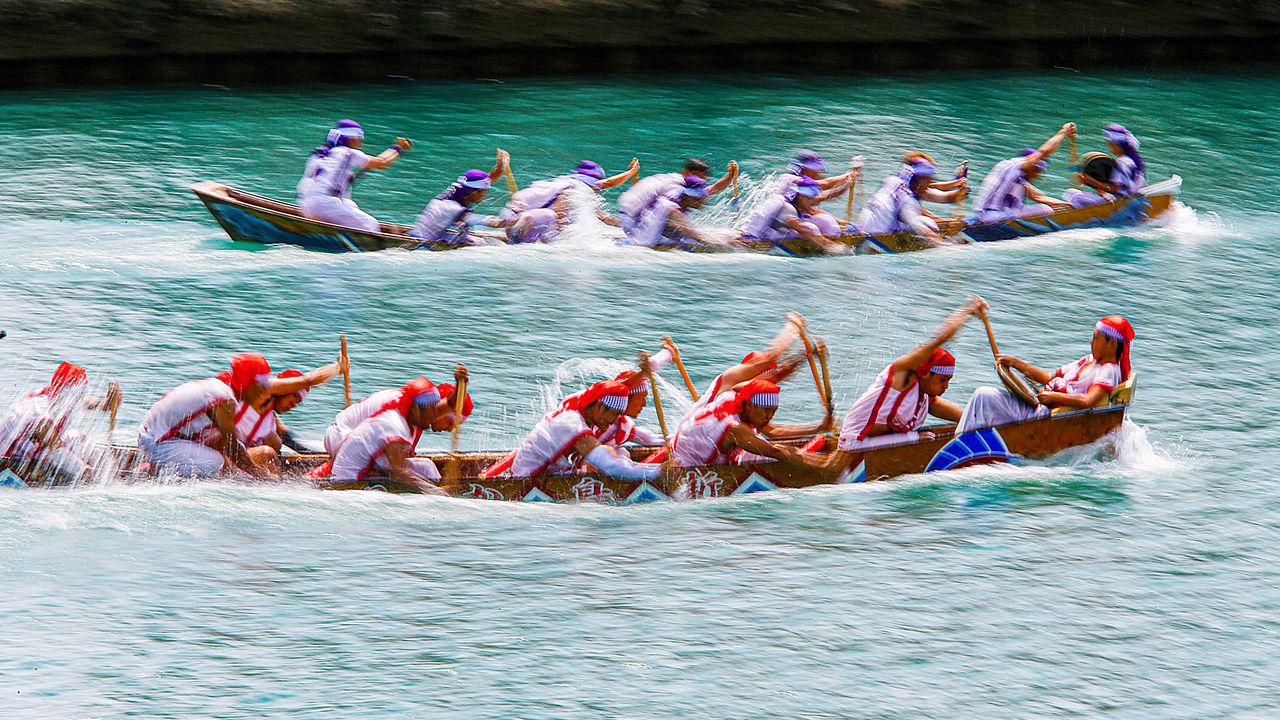
Across the Water: Three Japanese Boat-Racing Festivals
Guideto Japan
Culture- English
- 日本語
- 简体字
- 繁體字
- Français
- Español
- العربية
- Русский
Roots in Legends and China
Surrounded by the sea and blessed with numerous rivers and marshes, Japan is home to many festivals featuring boat racing. Among its oldest, the ancient morotabune ritual of Miho Shrine in Shimane Prefecture has its origins in the kuniyuzuri “transfer of the land” legend of the Izumo region. The festival recreates an episode where a boat with multiple rowers went to meet a messenger from the heavens. This ritual later developed into a race to give thanks for plentiful fish catches and abundant harvests.
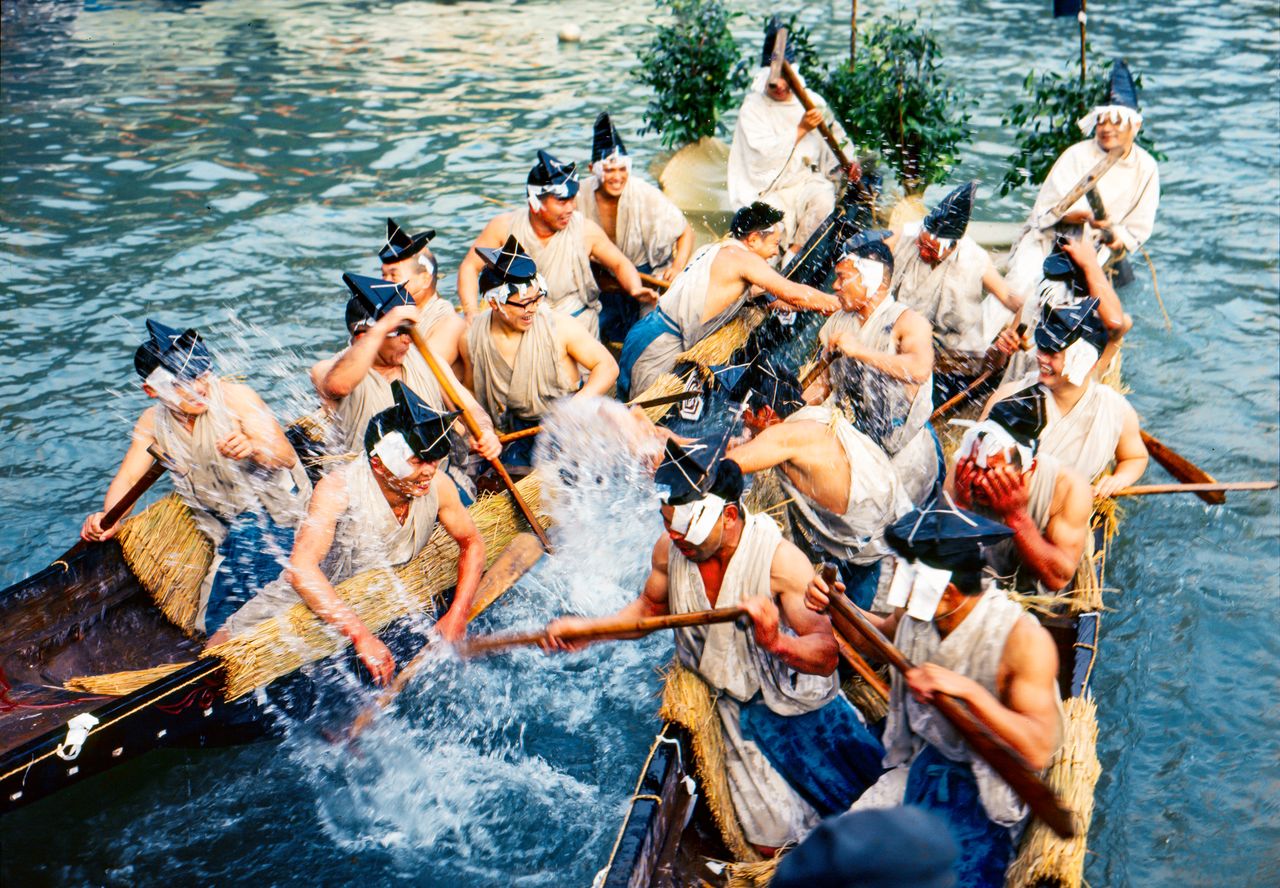
The morotabune Shintō ritual takes place on December 3 in Mihonoseki. (© Haga Library)
In various parts of the country, similar rituals mobilizing multiple rowers gradually evolved into heated races. Others, such as the hārē in Okinawa, are descended from the dragon boat races that spread from China.
These races demand crews rowing in tight coordination; even one rower out of sync can slow a boat considerably. Experienced rowers pass their skills on to new crew members, all of them practicing diligently until they can move smoothly as a unit. These events, which have religious aspects, also help strengthen solidarity among shrine parishioners. Here we present three fine examples of rituals that also highlight local pride.
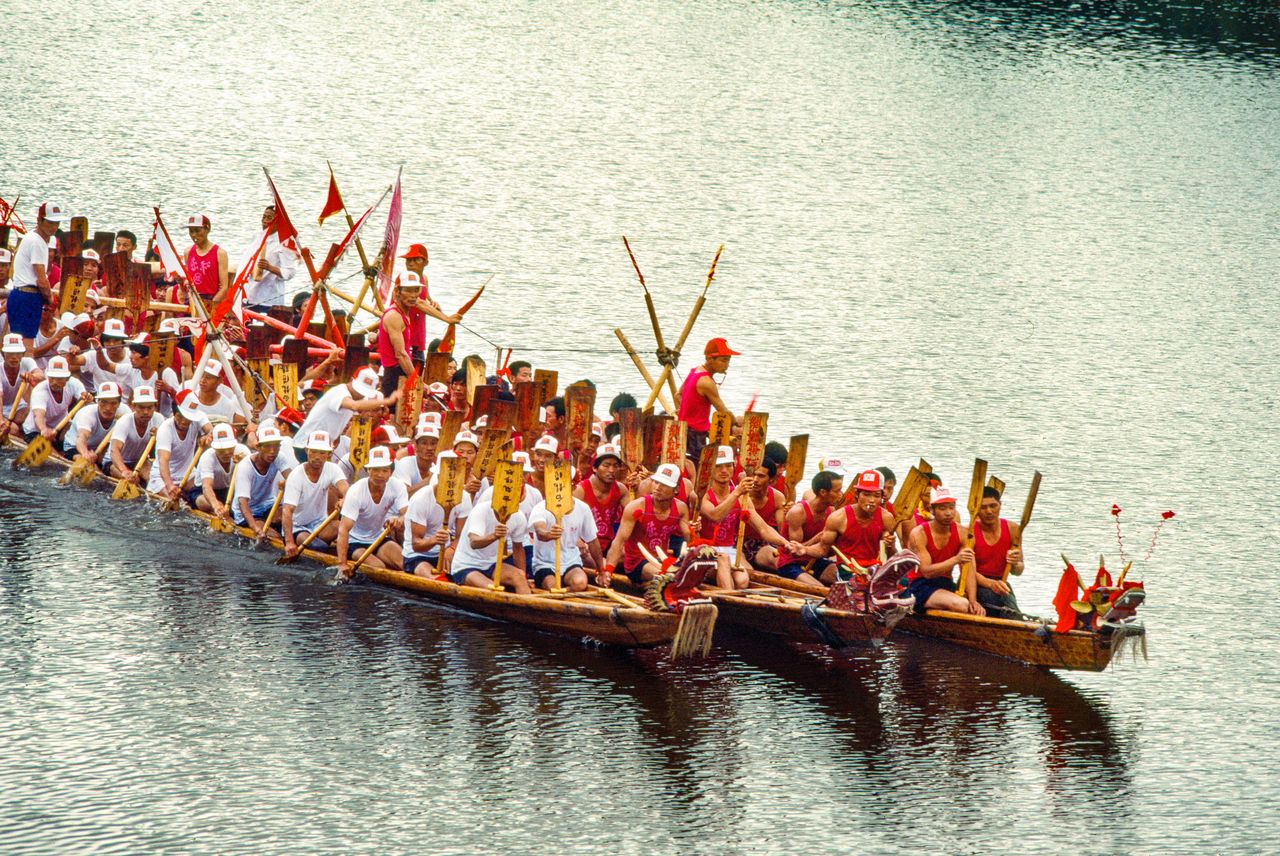
A dragon boat race on a tributary of China’s Miluo River. A dragon head sculpture decorates the boat’s prow. (© Haga Library)
Itoman Hārē
(Fourth day of fifth month on the traditional calendar, Itoman, Okinawa Prefecture)
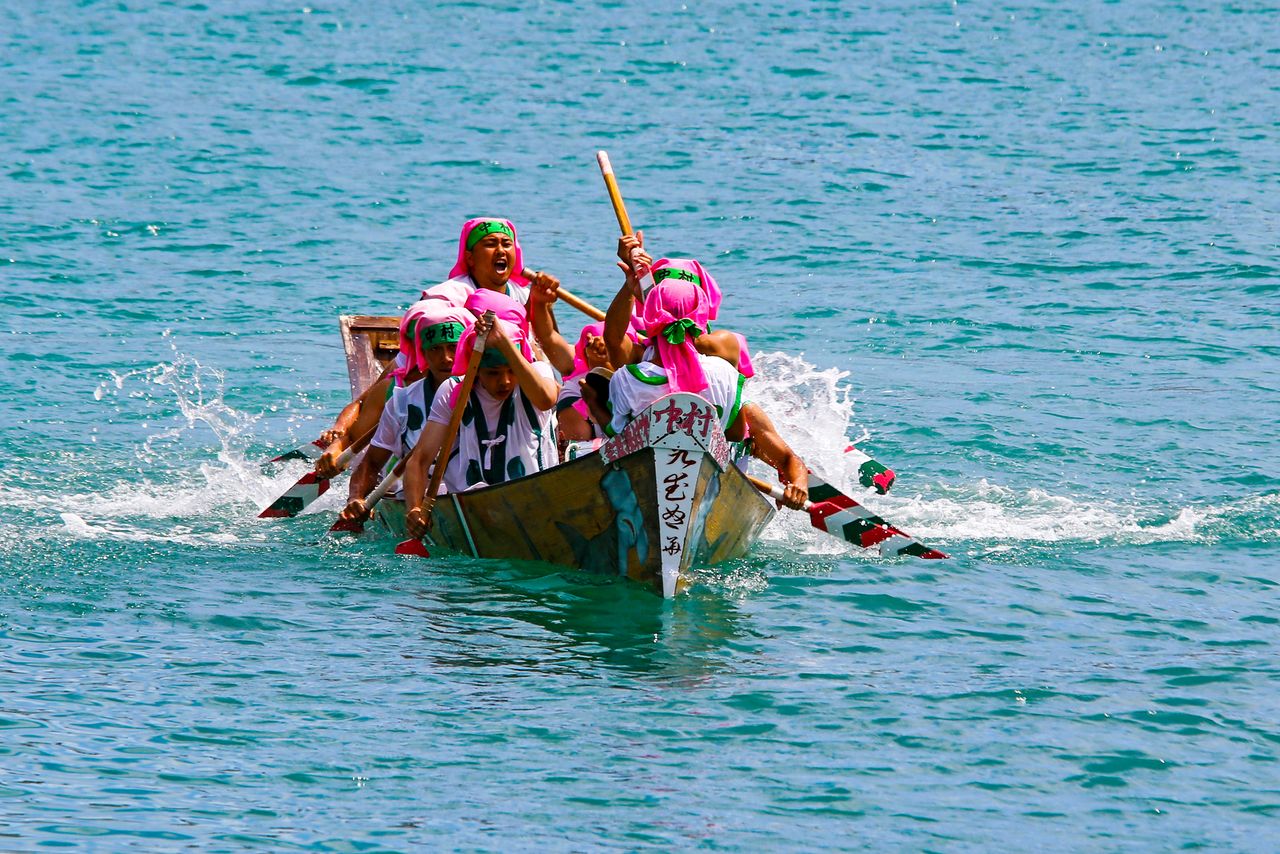
Nowadays, the race is conducted mainly using traditional fishing boats. (© Haga Library)
In Okinawa, hārī races between traditional fishing boats are an annual early summer event, held on the fourth day of the fifth month according to the traditional calendar (in 2024, on June 9). The races are held in over 20 locations, including smaller islands in the Okinawa chain. In Itoman, a city at the southern tip of the main island, the race dates back 600 years and is called hārē locally.
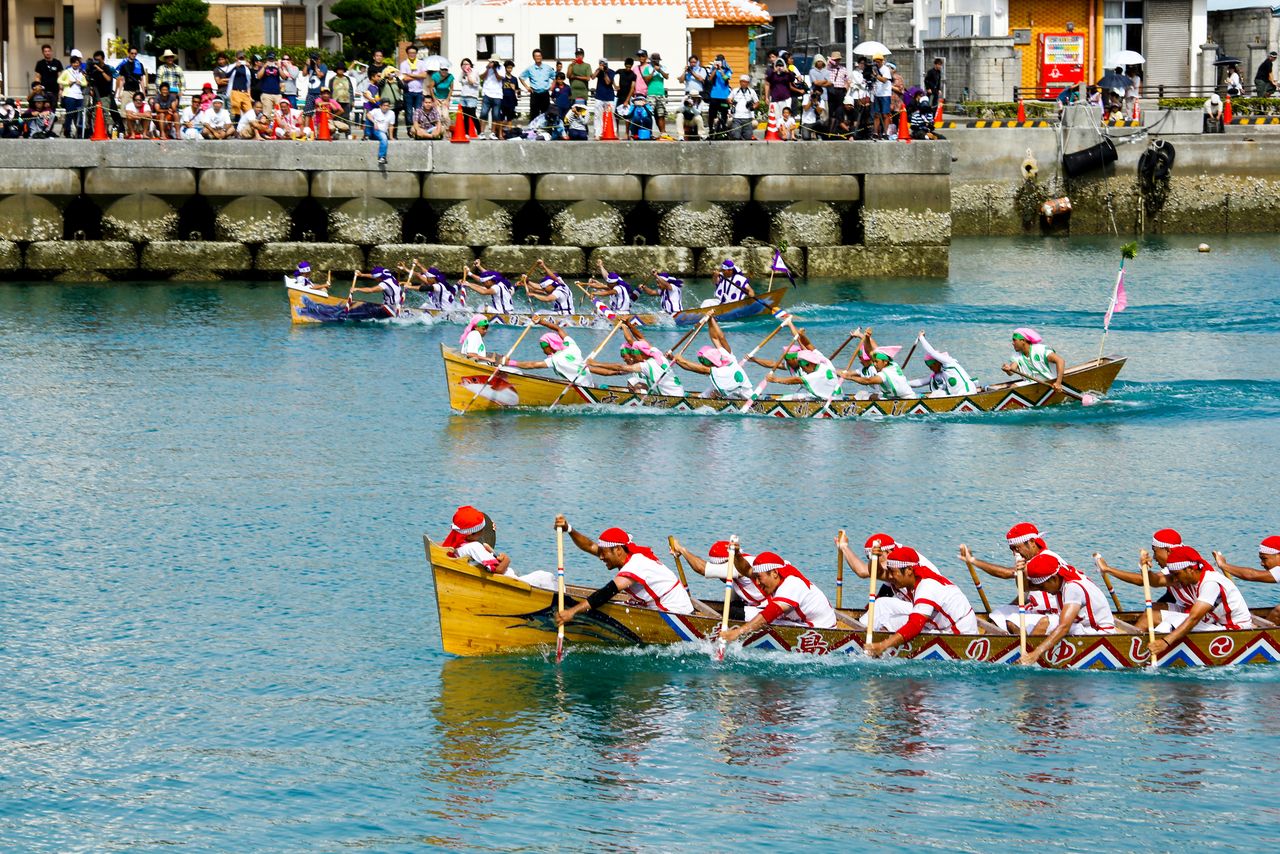
Three teams compete in the Itoman hārē. (© Haga Library)
There are several theories as to the origins of hārī. When Okinawa was known as Ryūkyū, there is a well-known story that the head of the Nanzan kingdom, after seeing a dragon boat race in Nanjing while studying there, was quite impressed and instituted a similar event in his area around the year 1400.
In the Ryūkyū kingdom era (1429-1879), hārē was a national event. But following annexation of the kingdom by Japan in 1879, the race became endangered as a result of the government’s religious policy banning such activities. Even so, Okinawans continued hārē by mounting the boats on wheels and racing them on land. This workaround continued for almost a century, until races on water resumed after the 1975 Okinawa International Ocean Exposition.
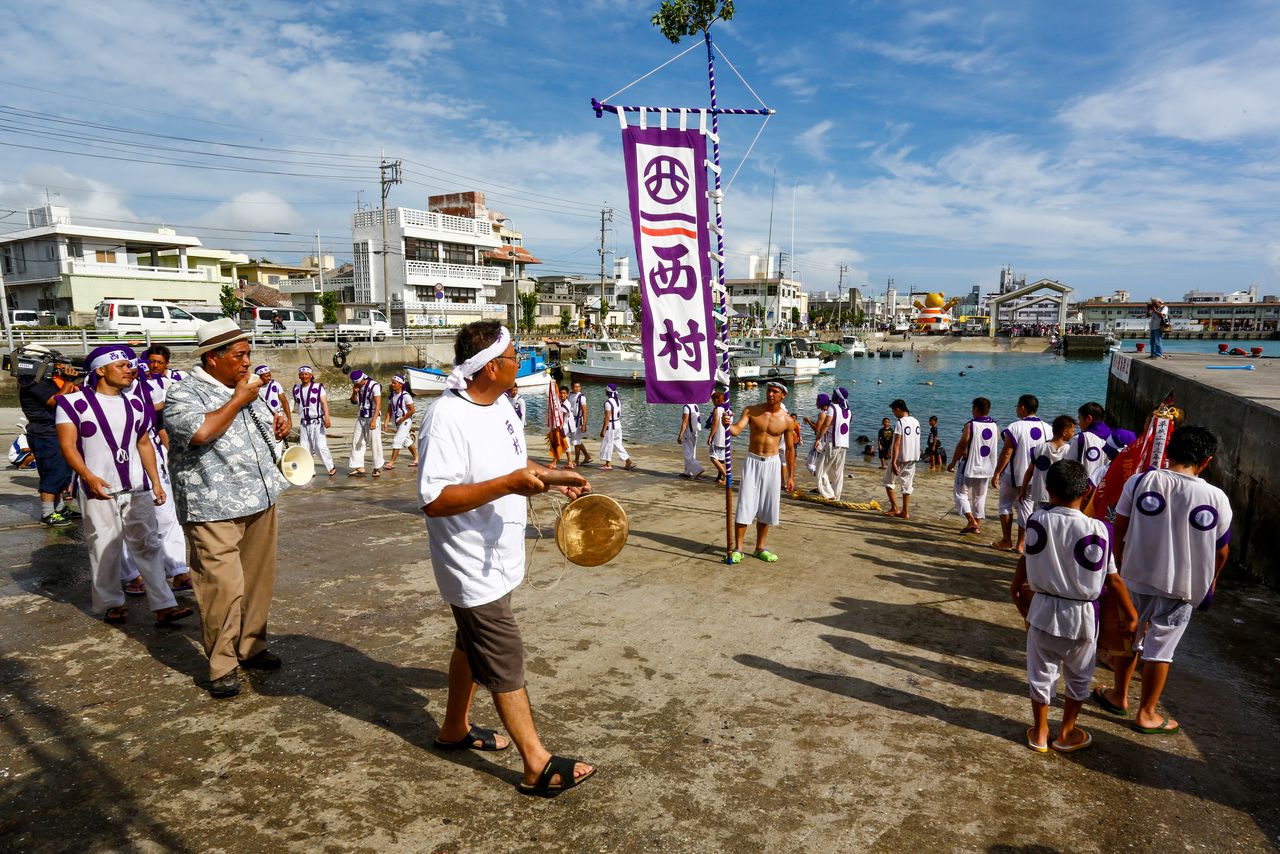
As race day draws near, the sound of hārē gongs reverberates through the city. (© Haga Library)
In the Itoman hārē, 60 teams from three districts compete; the boat with the most total points wins. On race day, representatives from the three districts gather in the early morning at a place of worship on a hill. In a ceremony led by a noro priestess, they give thanks to the kami of the sea and pray for plenty in the world and bountiful fish catches.
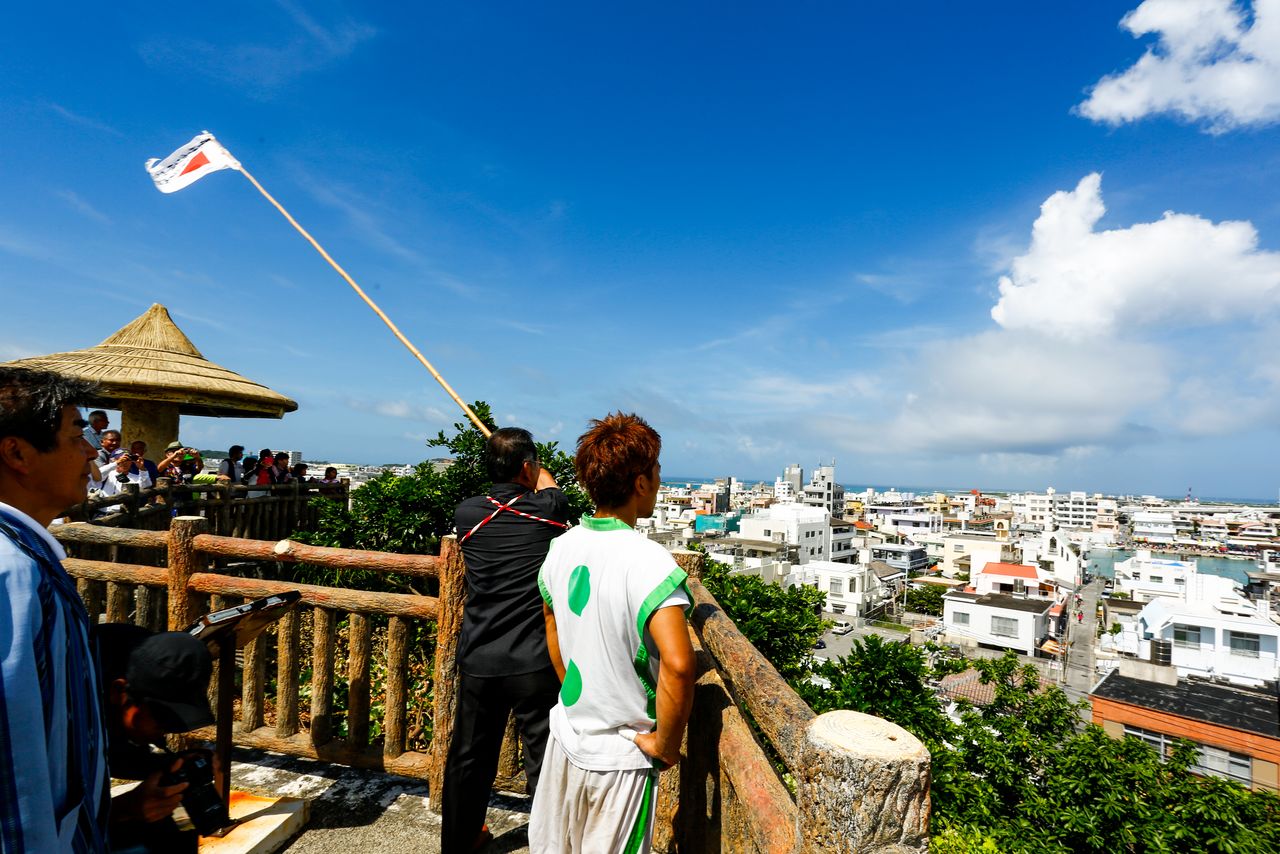
A descendant of the family assigned to the task by the Nanzan king waves the starting flag. (© Haga Library)
Following the ceremony, the starting flag is hoisted atop the hill and the ugan hārē starts in the Itoman fishing port below. In the race, traditional wooden fishing boats are crewed by 13 members from fishing cooperative youth divisions. Afterwards, crews gather at the shrine to the local kami, singing the hārē song and performing the kachāshī festive folk dance as offerings.
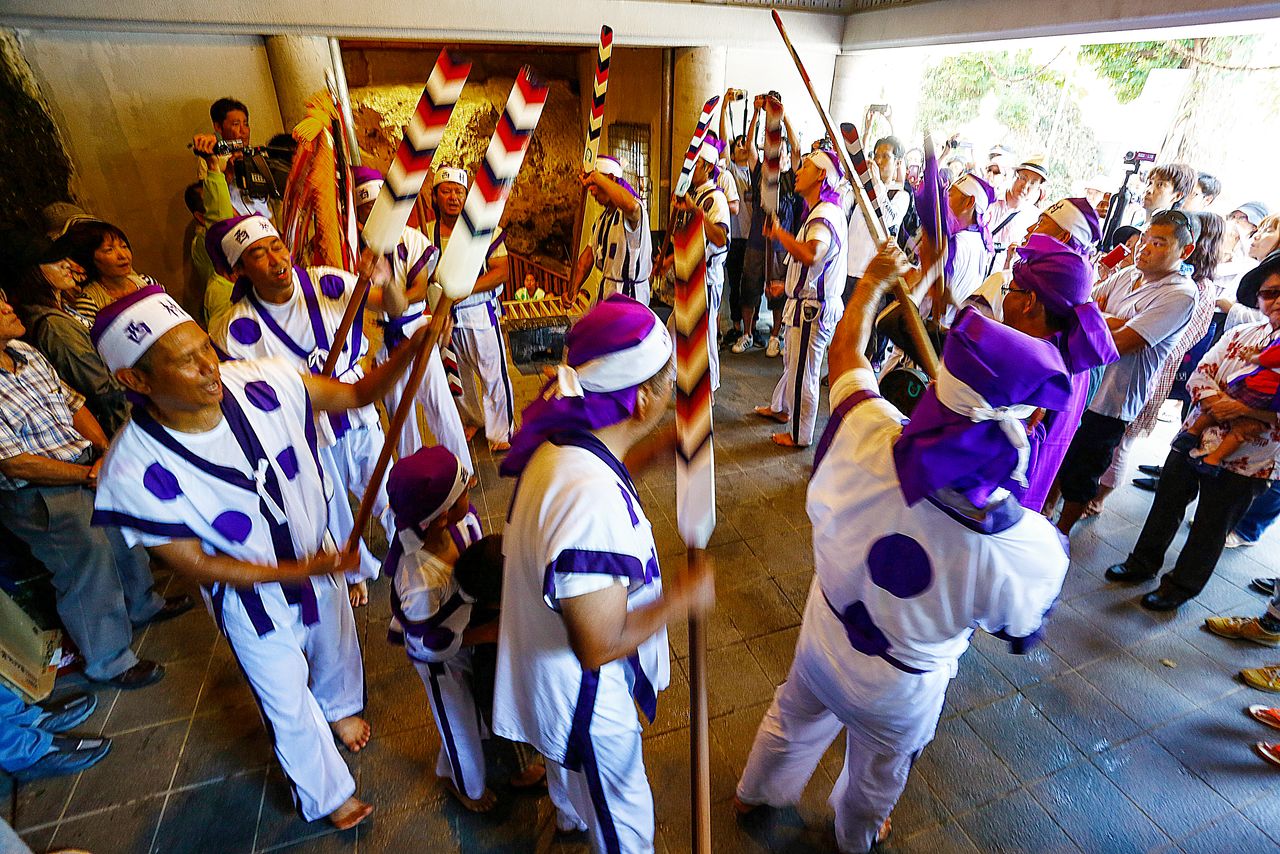
Singing and dancing with oars held high. (© Haga Library)
More racing follows in the port, with youth, junior high school, and workplace groups competing. The highlight of this portion of the event is the kunnukasē: one of the boats is intentionally capsized and righted again, after which crews resume rowing. Surely this is a rather unusual feature of a boat race.
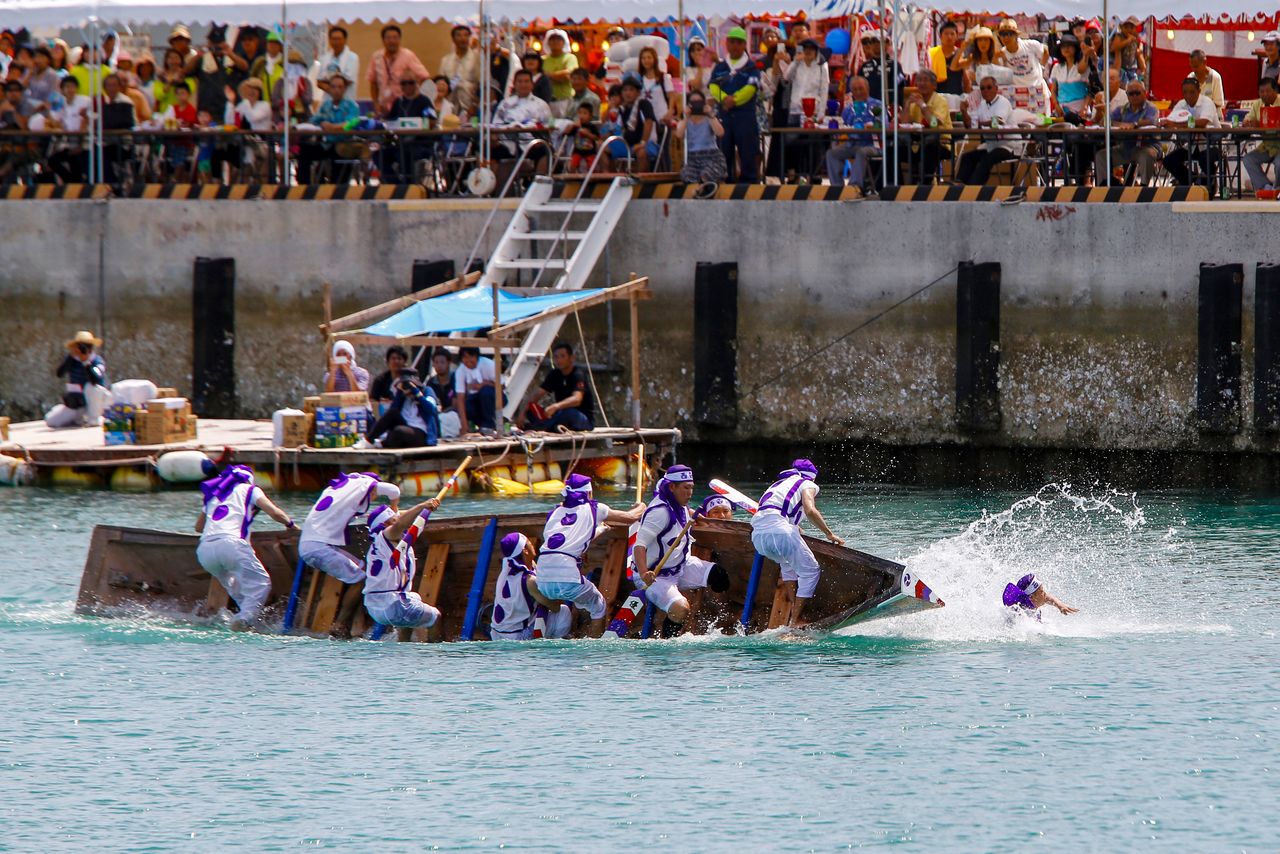
One part of the race involves capsizing a boat; this doubles as training in the case of fishing boat accidents. (© Haga Library)
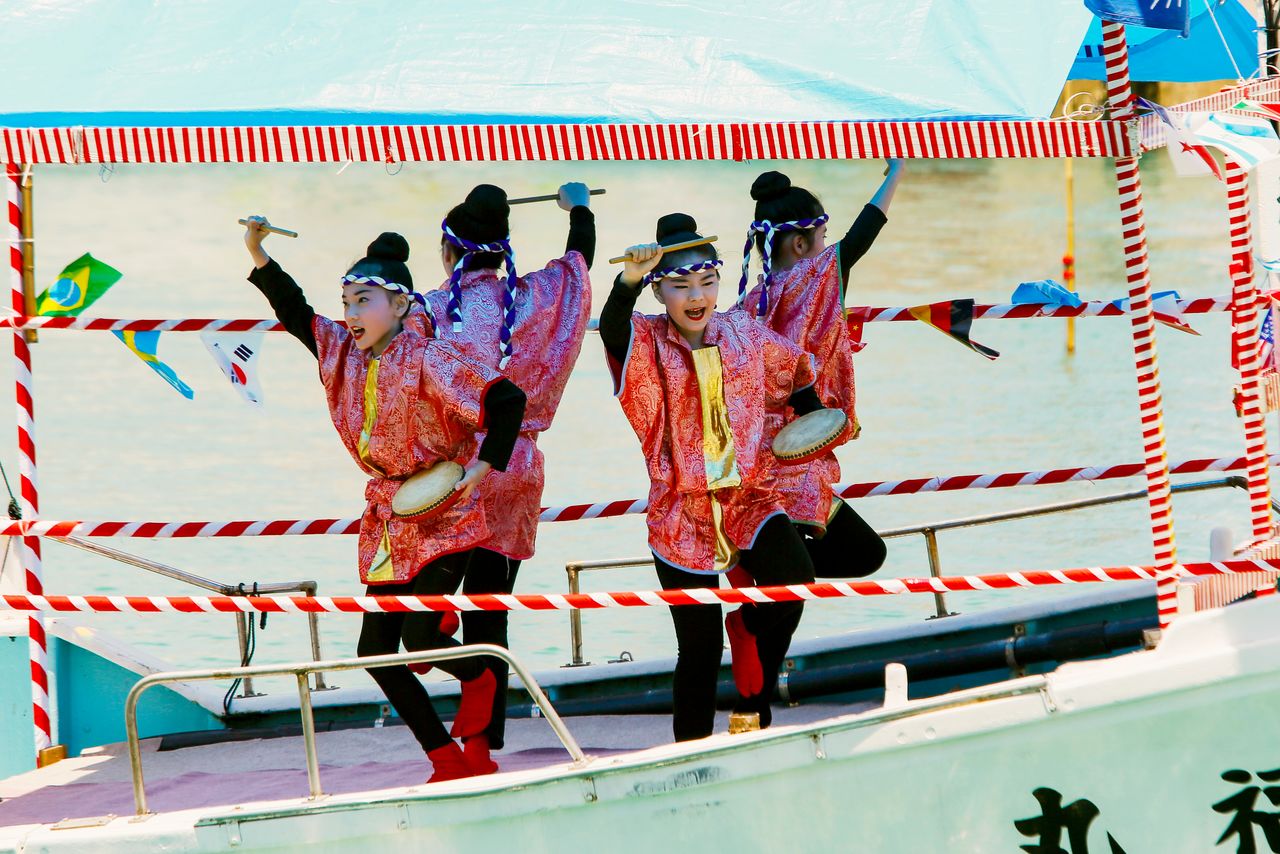
In between races, girls aboard a fishing boat dance to shimauta traditional folk music. (© Haga Library)
The last race of the day is the agaisūbu, an out-and-out speed race upon which hangs the prestige of the three competing districts. This 2,150-meter race sees three boats, one from each district, circle the port three times; the evenly matched teams race neck and neck to a thrilling finale. On land, residents from the winning district celebrate by singing and dancing.
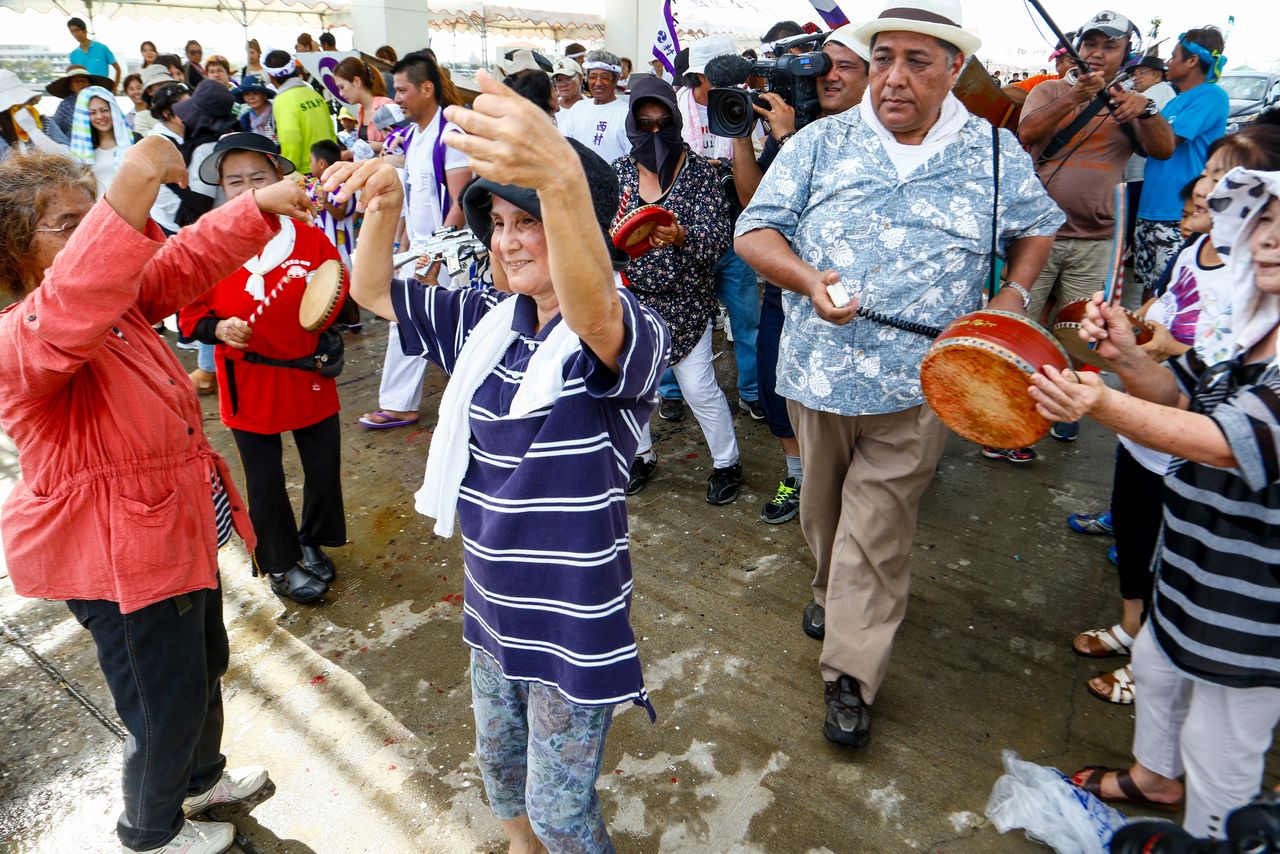
At the end, spectators perform the kachāshī in celebration. (© Haga Library)
Mifune Matsuri, Kumano Hayatama Shrine
(October 16, Shingū, Wakayama Prefecture)
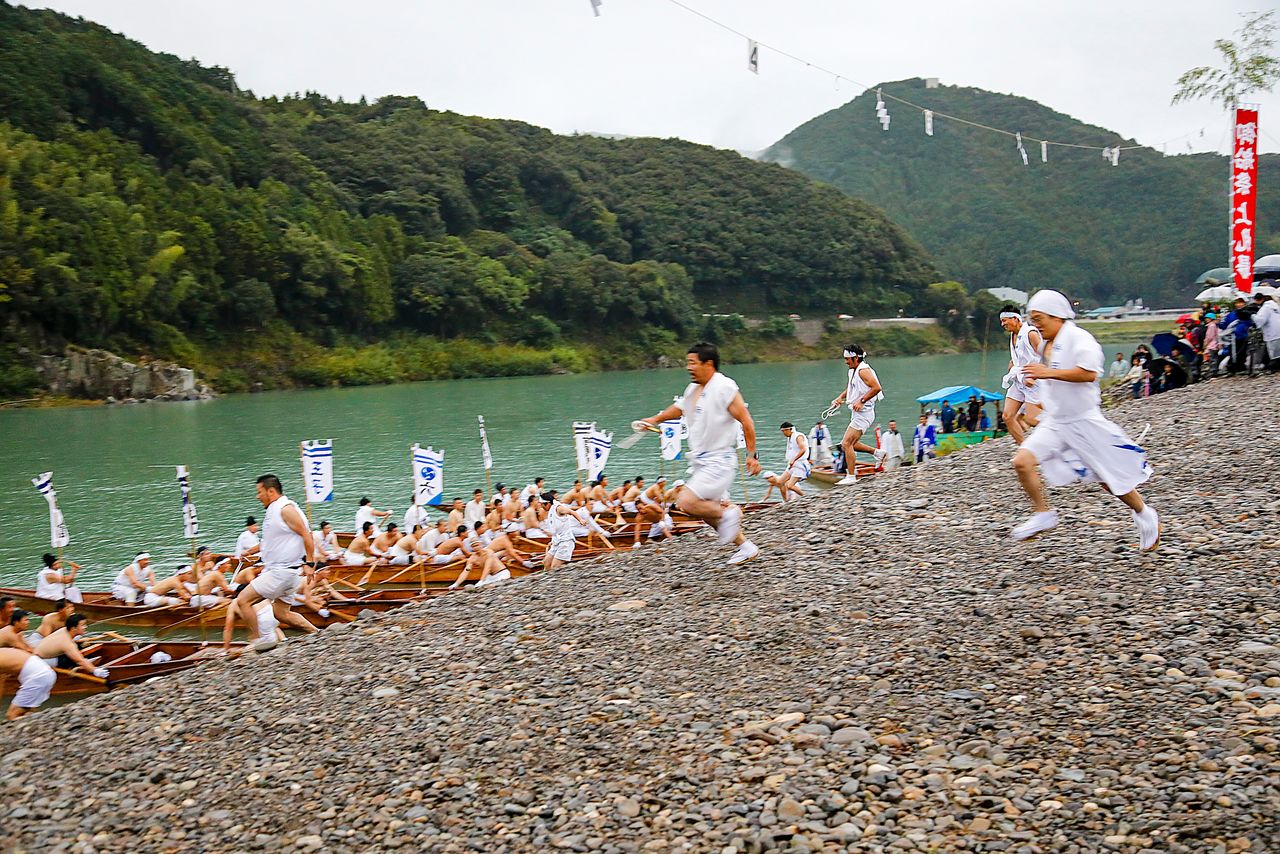
Nine traditional craft participate in the race. (© Haga Library)
The pilgrimage route along the Kumano River in the Kii Peninsula runs from the river’s estuary, where Kumano Hayatama Shrine is located, upstream to Kumano Hongū Shrine. This route is part of the Sacred Sites and Pilgrimage Routes in the Kii Mountain Range UNESCO World Heritage Site. The Mifune Matsuri, a boat race on the second day of the annual Kumano Hayatama Shrine festival, takes place on this river.
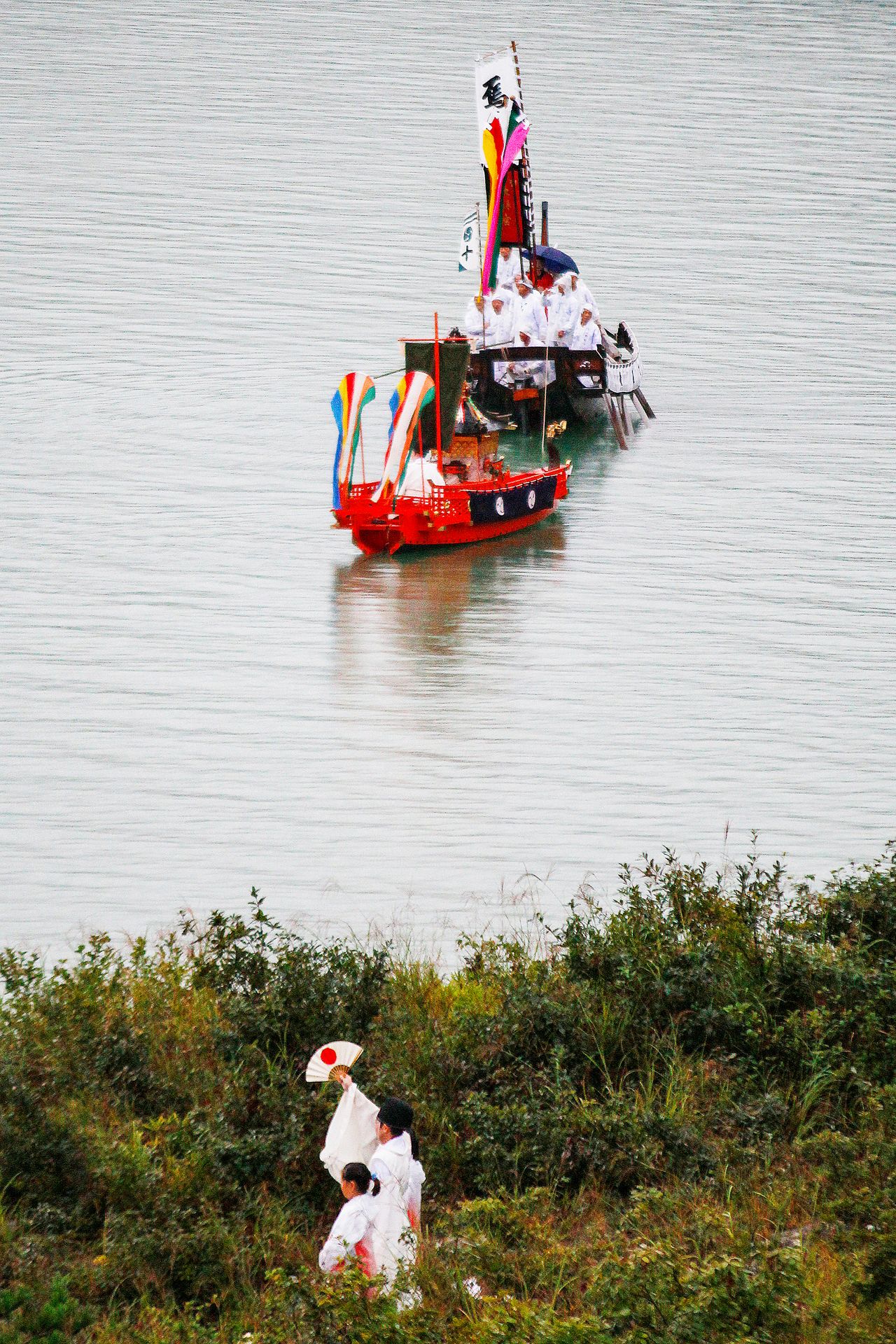
The vermillion shinkōsen ceremonial vessel, pulled by one of the rowboats, slowly approaches the shore. (© Haga Library)
The race begins at Gongengawara, northeast of Hayatama Shrine near Shin-Kumano Bridge. After the mikoshi portable shrine is carried onto the shinkōsen vessel, fast rowboats from nine districts race 1.6 kilometers upstream, circle Mifune Island three times, and then race back toward the goal on the opposite shore at Otomo.
During the race, which lasts about 16 minutes, rowers ply the oars 600 times, their creaking echoing against the river banks. As the boats near the home stretch, they ram each other as they attempt to take the lead, providing a thrilling sight for spectators.
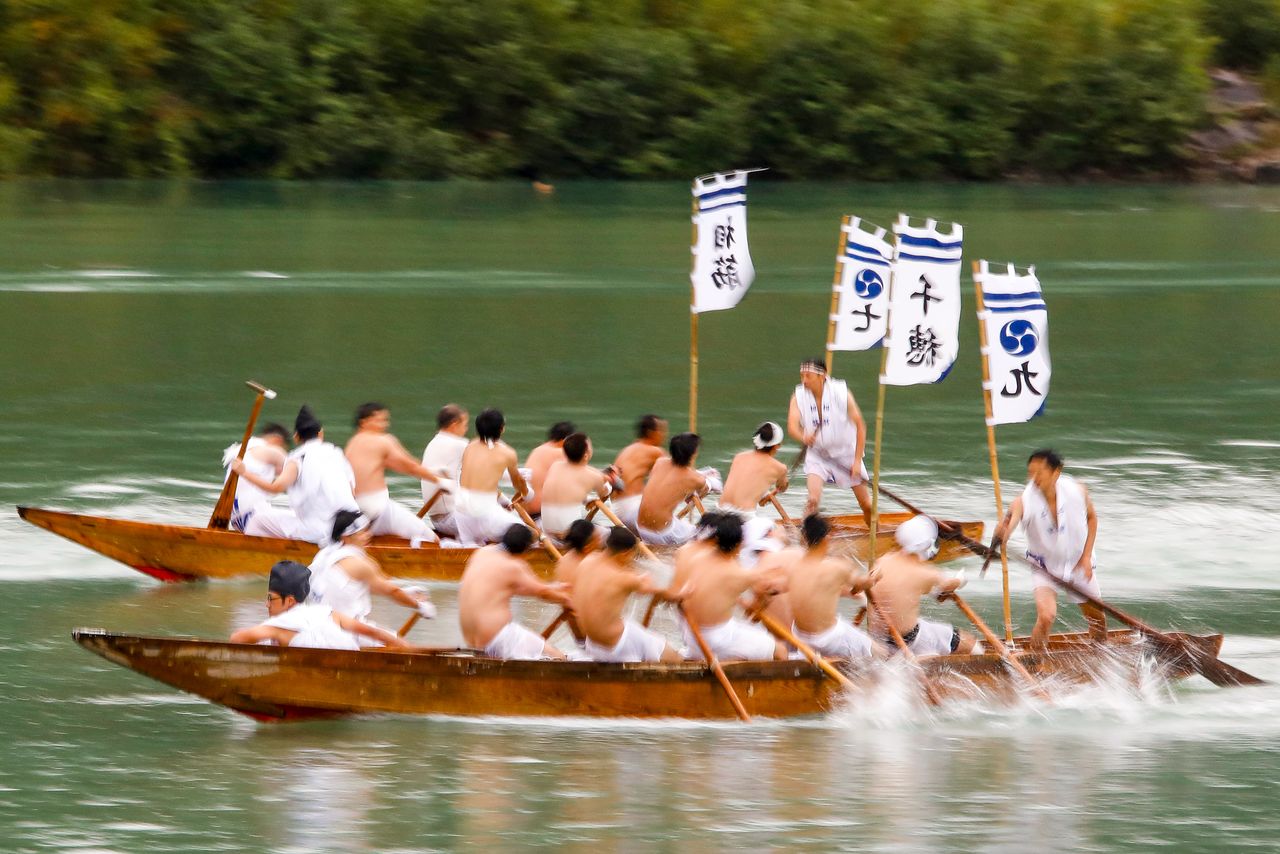
The 11-man crews are full steam ahead as they row upstream. (© Haga Library)
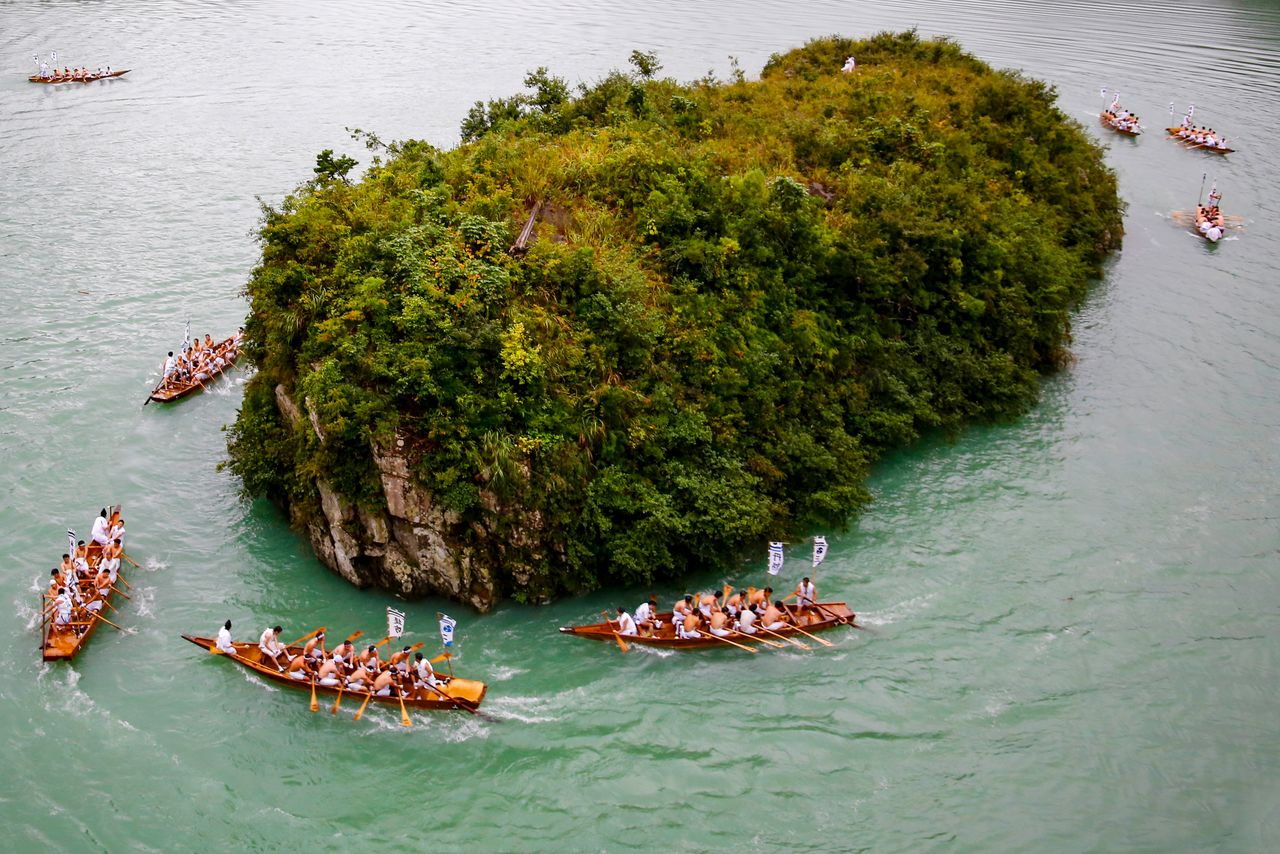
Boats vying for the lead as they circle the island. (© Haga Library)
After rounding the island, the boats resume the race. By the time the shinkōsen bearing the kami reaches Otomo, dusk has fallen. The kami is placed in a temporary shrine built with fresh cedar leaves, and a dance to appease the divine spirit is performed by firelight, creating a mystical atmosphere far removed from the just-concluded frenetic race.
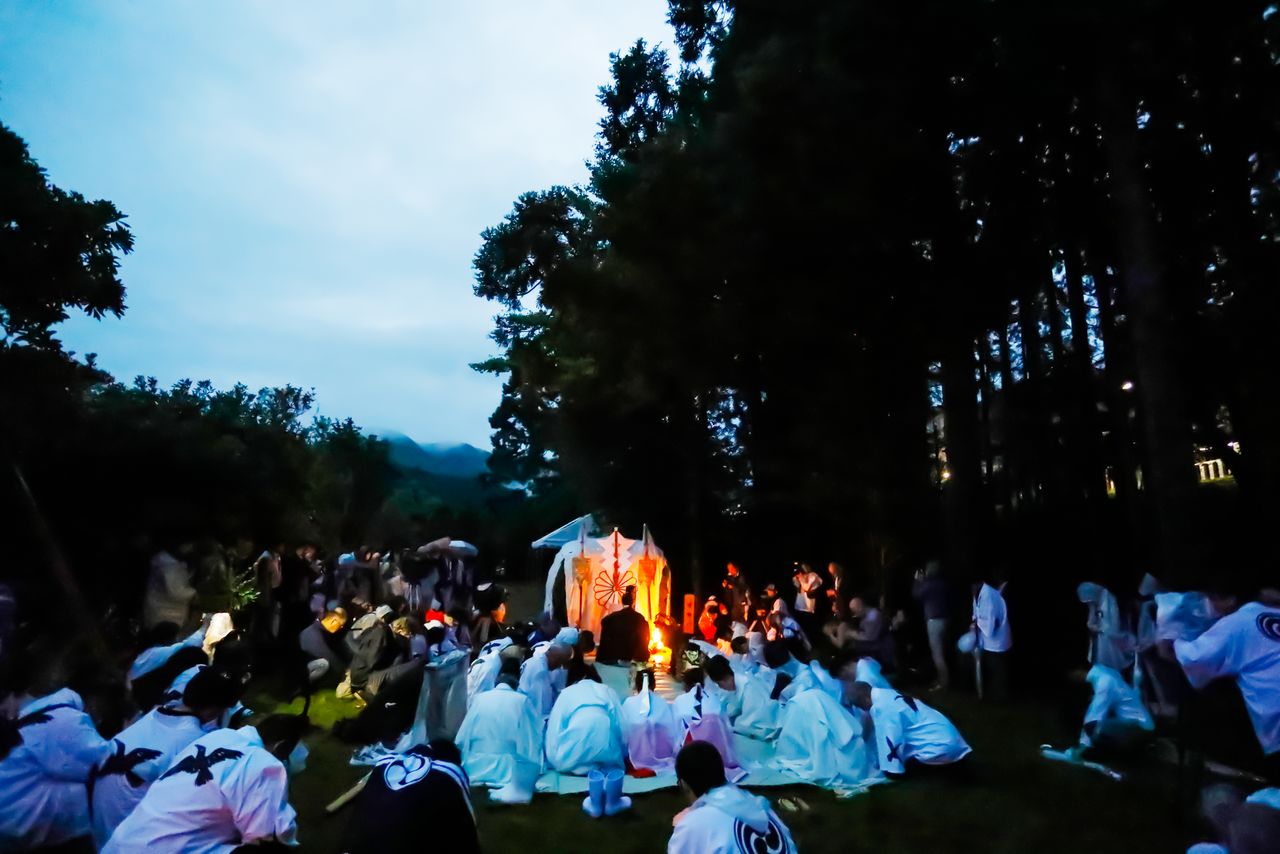
The temporary shrine recreates the one that welcomed the kami in antiquity. (© Haga Library)
Higashino Sumiyoshi Matsuri
(August 13, Ōsaki Kamijima-chō, Hiroshima Prefecture)
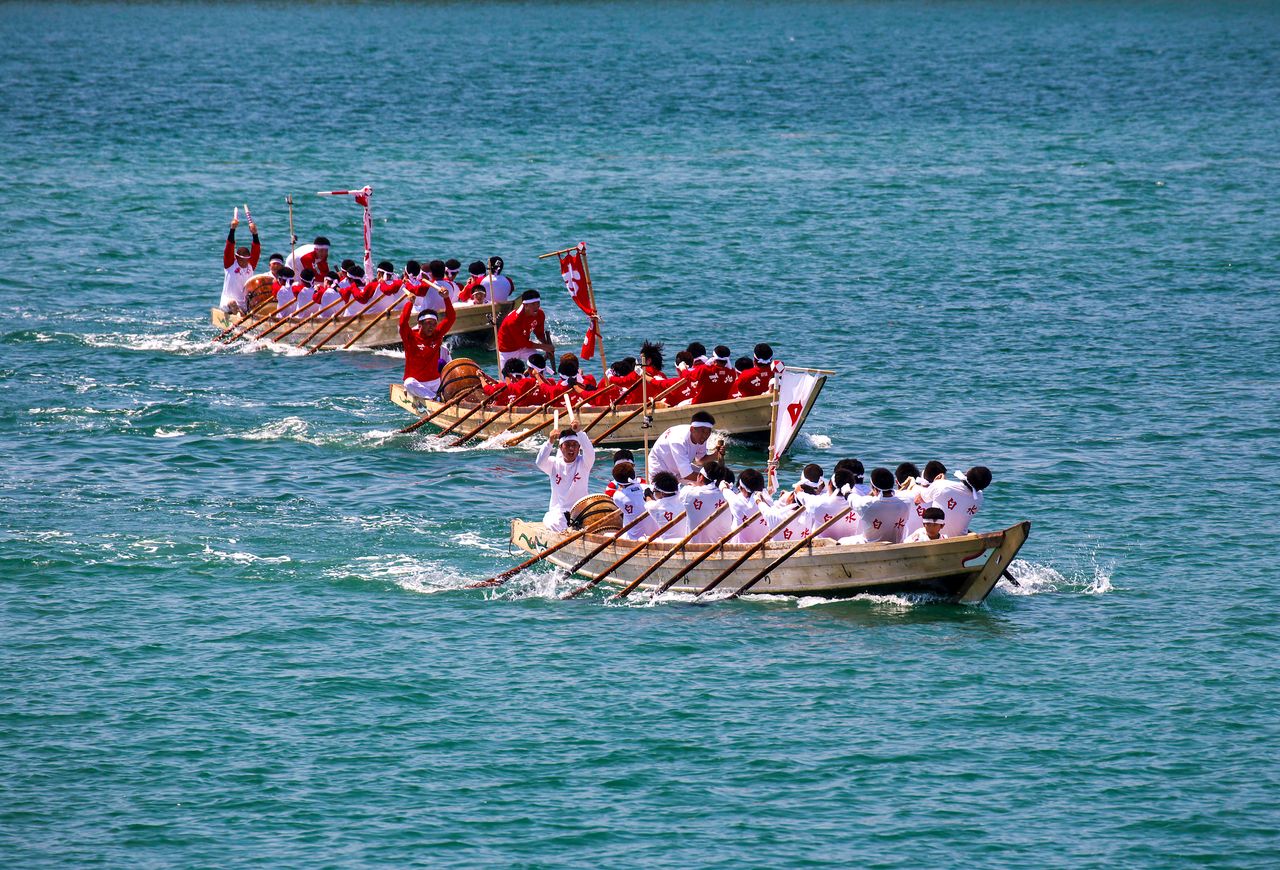
The plain watercraft have sharp lines reminiscent of Japanese swords. (© Haga Library)
Kaidenma racing has been a cultural tradition on Ōsaki, an island in the Seto Inland Sea, for generations. During the Muromachi period (1336–1568), the island was the redoubt of pirates led by the Kobayakawa clan of Bitchū (part of present-day Okayama Prefecture). To convey messages and ferry goods between main vessels and land-based forces, the pirates used highly maneuverable small craft called kaidenma, which allowed them to control the waters during that era.
In the northeastern corner of the island at Higashino stands Sumiyoshi Shrine (since incorporated into Hachiman Shrine), protector of the seas. In 1827, kaidenma began leading the vessel carrying the mikoshi shrine during the annual festival. Sometime in the nineteenth century, the procession transformed into a speed race featuring skirmishing reminiscent of pirate days. Since the 1950s, though, the race has become more of a sporting competition.
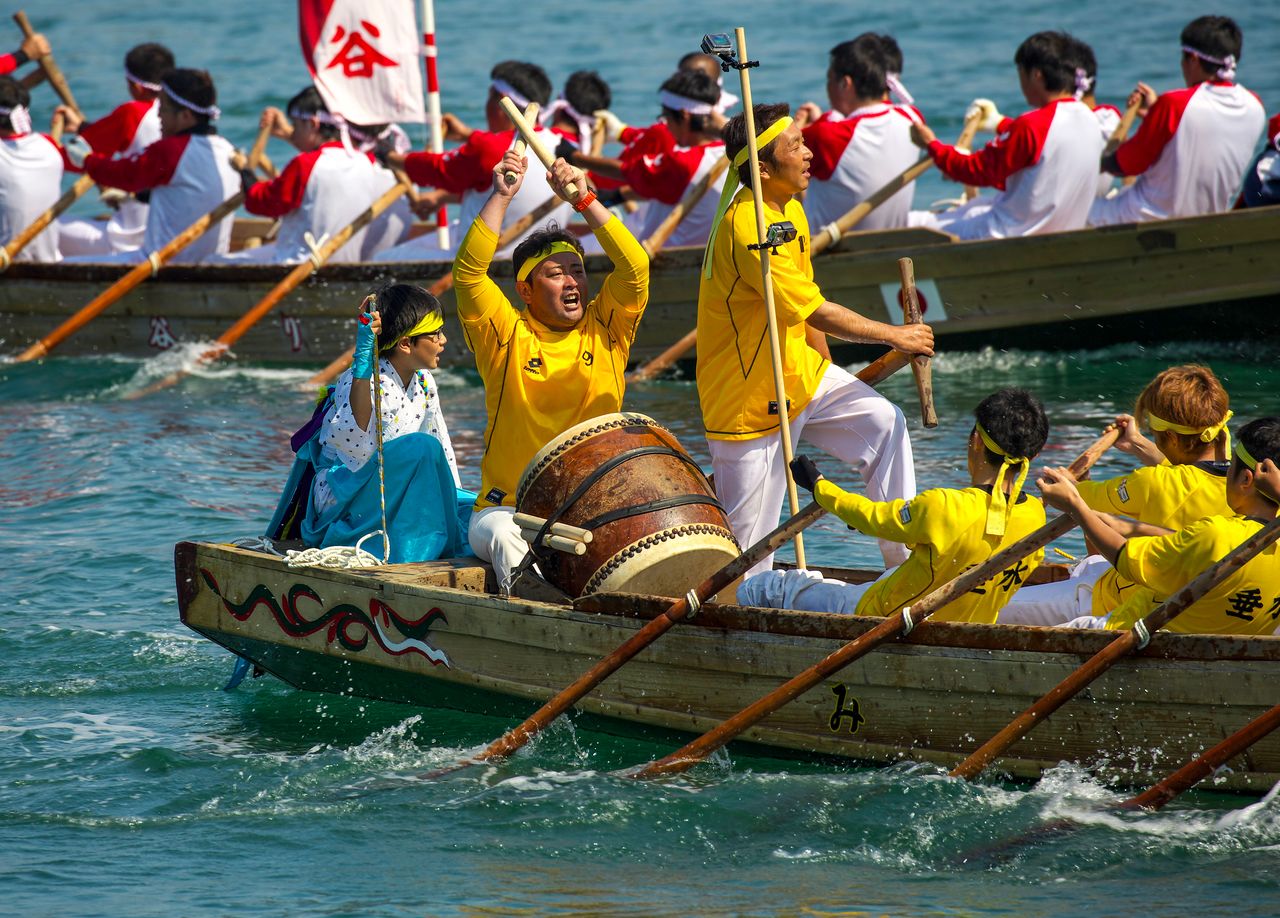
The beat of the drum helps rowers keep perfect time. (© Haga Library)
Today, four local districts compete in the race, their boats continuously modified to gain even the slightest speed advantage. The teams, working with master boatbuilders, continually refine their designs, which are closely guarded by each district. There is also a knack to rowing the boats. The rowers, bending forward, dip their oars vertically into the water and then spring back to attain maximum momentum. The rowing demands both physical strength and fine coordination, and practice sessions take place over many months.
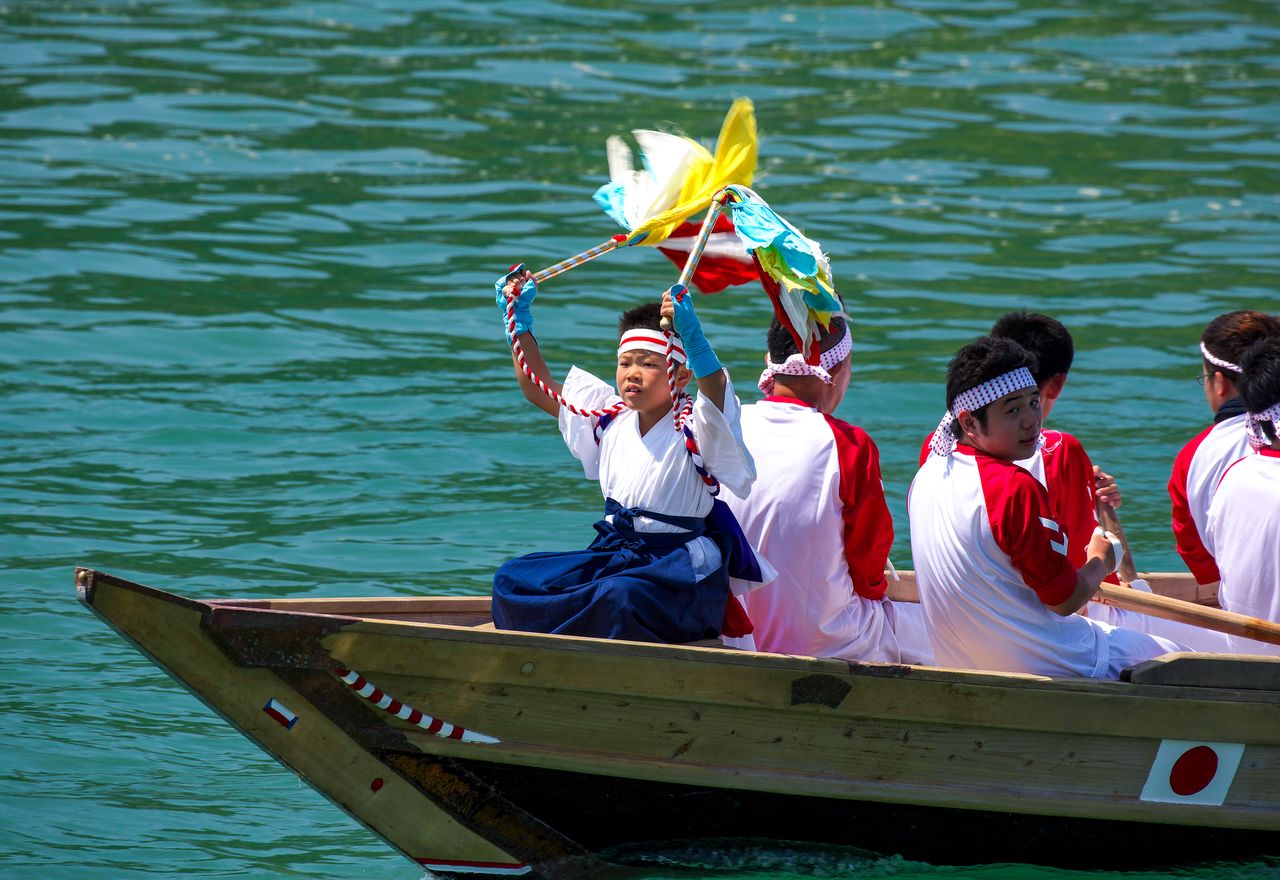
The boats carry 16 oarsmen. A young boy in the prow cheers his team on. (© Haga Library)
At the festival, the competition among the four boats plays out in four heats; the boat earning the highest total points wins. Each boat carries 14 rowers, a taiko drummer who sets the rhythm, a lead boatman with a large oar directing the boat’s course, and young cheerleader boys in the prow and stern.
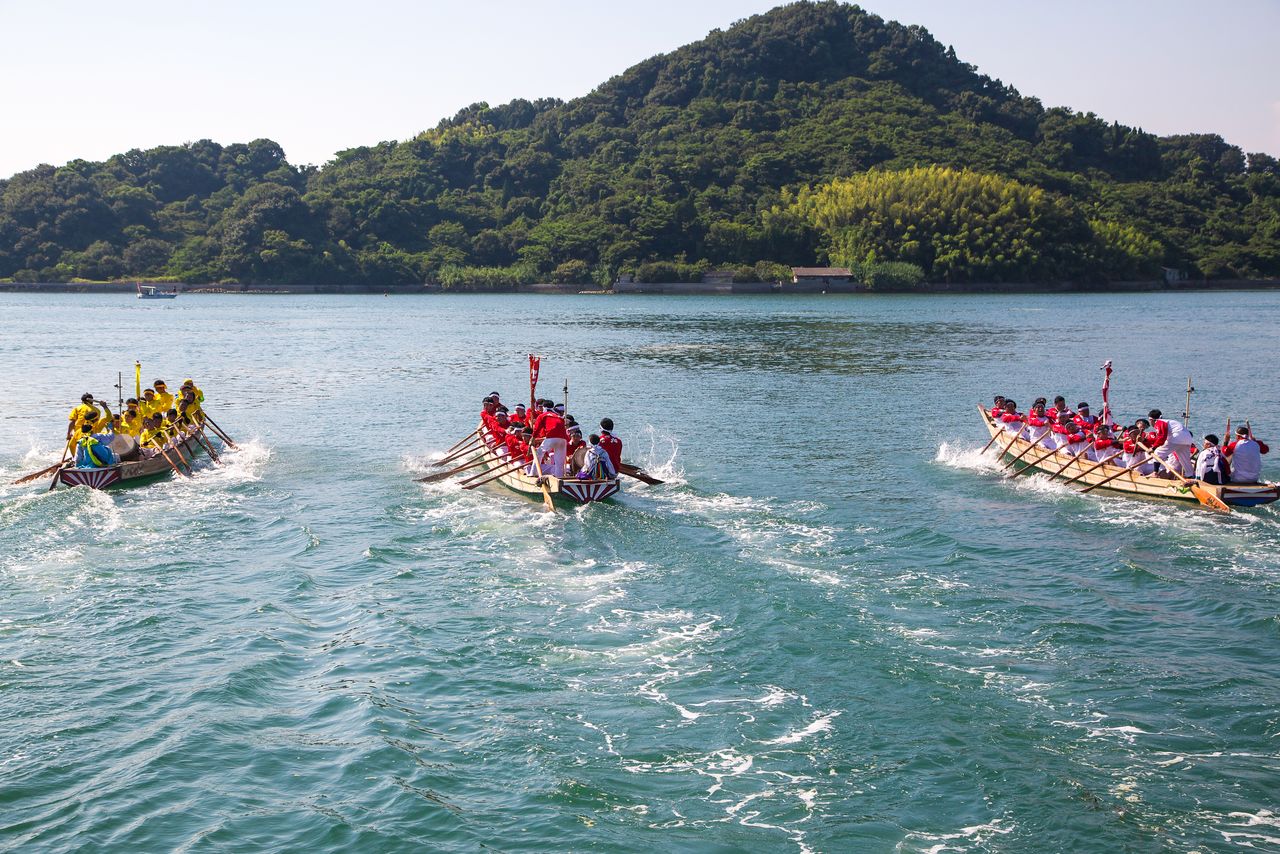
The lead boatman’s ability to read the current spells the difference between winning and losing. (© Haga Library)
On the course’s return leg, the front-runners bump into each other as they vie for the lead, losing speed and being overtaken by others further behind. Equipment, stamina, skill, and grit are all necessary, but strategy also plays a part in winning the race.
The sight of the crews rowing in perfect unison and propelling their boats at full speed thrills spectators on the shore. A “junior” kaidenma race, for children ages 11 and up, also takes place, helping nurture the next generation of racers.
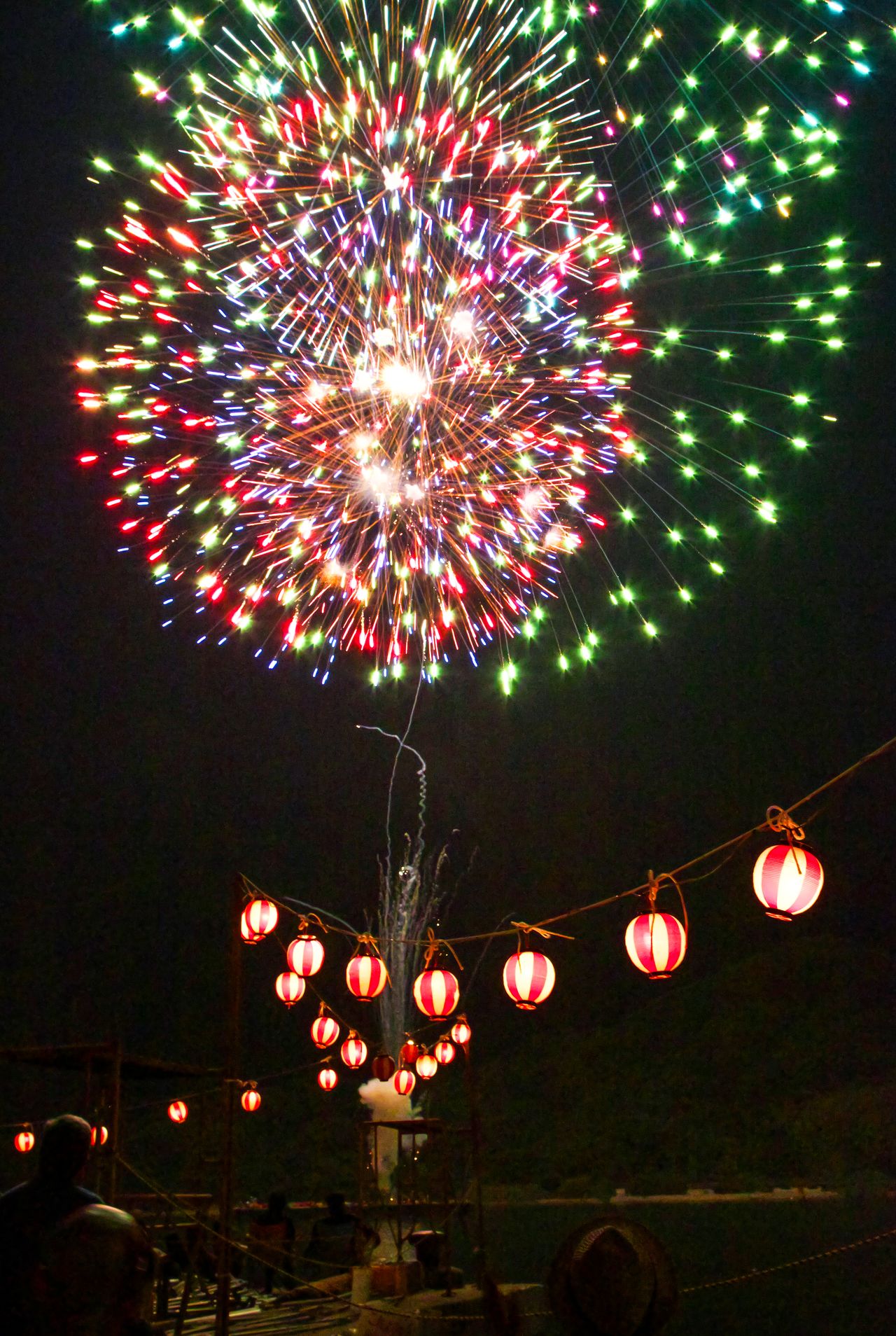
Spectacular fireworks illuminate the night sky in celebration. (© Haga Library)
(Originally published in Japanese. Dates given are those on which the festivals are usually held. Banner photo © Haga Library.)
